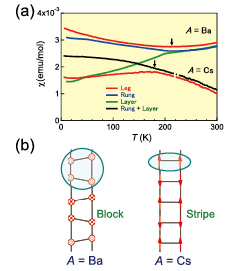Magnetism of Fe-Based Ladder Compounds
Ohgushi, Sato, Y. Ueda, and Uwatoko Groups
Since the discovery of superconductivity at high transition temperature in LaFeAsO1-xFx, the study of Fe-based superconductors has become a main stream in condensed matter physics. The basic structural feature of Fe-based superconductors is a square lattice of Fe atoms coordinated tetrahedrally by pnictogens or chalcogens. The most common magnetic structure realized in parent materials is a stripe order, which is stabilized by Fermi surface nesting and the orbital ordering. More recently, a block order was found in A2Fe4Se5 (A = K, Rb, and Cs); an important feature of this ordered phase is a large magnetic moment 3.3 μB as a consequence of the strong electron correlation effect [1]. To gain further insights into the mechanism and variation of these magnetic orders, investigation of Fe-based compounds with various dimensions is important, because the dimensionality strongly influences the itinerancy of electrons.

Fig. 1. (a) Temperature (T) dependence of the magnetic susceptibility (χ) at 5 T for Fe-based ladder compounds AFe2Se3 (A = Ba and Cs). (b) Magnetic structures determined by neutron diffraction experiments. Brock and stripe orders are realized in A = Ba and Cs, respectively.
We investigated electronic properties of Fe-based chalcogenides AFe2Se3 (A = Ba and Cs), in which Fe atoms form a quasi-one-dimensional ladder structure [2, 3]. Both compounds are Mott insulators due to prominence of the electron correlation effect in low-dimensional systems. The magnetic susceptibility shows anomaly corresponding to the magnetic order at 255 and 175 K for A = Ba and Cs, respectively. Interestingly, magnetic structures determined by neutron diffraction experiments are distinct in between: whereas magnetic moments of 2.8 μB perpendicular to the ladder plane are arranged to form a Fe4 ferromagnetic unit and each Fe4 stacks antiferromagnetically in A = Ba (block order), magnetic moments of 1.8 μB along the leg direction couple ferromagnetically and antiferromagnetically along the rung and leg directions, respectively, in A = Cs (stripe order). These magnetic properties are partly explained by recent Hartree-Fock calculations for the five-orbital Hubbard model [4]. Our results demonstrate that magnetism of Fe-based superconducting materials is rather complex owing to the multi-band effect and/or the electron correlation effect.
References
- [1] P. Dai, J. Hu, and E. Dagotto, Nat. Phys. 8, 709 (2012).
- [2] Y. Nambu, K. Ohgushi, S. Suzuki, F. Du, M. Avdeev, Y. Uwatoko, K. Munakata, H. Fukazawa, S. Chi, Y. Ueda, and T. J. Sato, Phys. Rev. B 85, 064413 (2012).
- [3] F. Du, K. Ohgushi, Y. Nambu, T. Kawakami, M. Avdeev, Y. Hirata, Y. Watanabe, T. J. Sato, and Y. Ueda, Phys. Rev. B 85, 214436 (2012).
- [4] Q. Luo, A. Nicholson, J. Rincón, S. Liang, J. Riera, G. Alvarez, L. Wang, W. Ku, G.D. Samolyuk, A. Moreo, and E. Dagotto, Phys. Rev. B 87, 024404 (2013).
